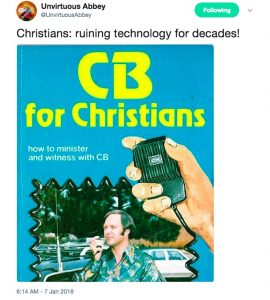
Seth Godin, “Not Lies, Storytellers,” All Marketers are Liars (blog), October 4, 2012, http://sethgodin.typepad.com/all_marketers_are_liars/2012/10/not-liars-storytellers.html
There’s a famous quote, often attributed to St. Francis of Assisi that says, “Preach the Gospel at all times. When necessary use words.” As people of faith, communication to others matters. It influences how people see those who represent the faith, values, and offerings for ministry. How people of faith communicate authentically is important as well. When we communicate in various settings, across boundaries, there is potential to build community. Intentional communication is essential to building community. I chose this project because the information that we share matters. I wanted to look at building community around the information that was shared.
Identifying the Problem and Challenges
The problem wasn’t fully noticed, at first. It took time and was gradual as the newness of being pastor-in-charge shifted. It was in staff meeting, maybe at the end of my first six months at Sandy Springs UMC that I noticed it. Someone mentioned that the articles were due for the monthly newsletter, “The Dipper.” Audible groans were heard (and continued to be heard) throughout the next couple of years whenever that announcement was made. “Already?” “We just did that.” “It can’t be that time again.”

https://www.flickr.com/photos/75718307@N00/25567727606/in/photolist-e7ajH7-EXkhDL-e74J5M-e74LVk-6H6bBo-e7aqB7-4ErLSp-dSwxBV-e74GZk-e74L7r-e7amPJ-7X5Rmk-7v8mQS-asdsVT-e7anbW-e74Fnp-e74HxH-4Ew1CG-4ErLU4-4Ew1G5-5zXYDM-e7aotm-e7ao4w-e7anWA-4cqgNM-72JykW-atkGUp-5c12Us-e7aobo-e7anQ1-e7akGY-e7aojY-23KksEP-5GvWoK-e74JLD-e7akr7-5GPCQF-3qryrb-4Ew1E1-asCuL-G9bqS-dzhbLF-ARkAC-HHwC5c-oEeYBJ-46mL5K-6zVPCx-zWsH2W-oubNs1-rMhTCo
The staff of SSUMC had a problem, but it was hard to initially identify. There were a lot of factors that went into the communication at SSUMC: frequency, outlets of communication, expectations of long-time members, expectations of new members, outdated software, outdated (and sometimes bad) information, staff miscommunication, and a changing context of members surrounding the community, just to name a few of the challenges.
Meanwhile, absorbent amounts of money were being spent on newspaper advertising because members insisted on newspaper advertising because that’s the way it had always been done.
On top of the challenges, there was the acknowledgment that the way that SSUMC communicated had not been adopted to the changes in the community and the life of the church. Communication was one sided and filled with insider information. In short, the church was in the advertising business. It had not ventured into marketing.
Are Churches in the Advertising or Marketing business?
So what’s the difference between advertising and marketing, and why does it matter to a congregation of faith? Well, it’s hard for churches to admit that they are in the marketing business, or even need to be marketing at all. It sounds like something you see on TV, or it reeks of manipulation.
Andy Havens, a contributor at the website, Church Marketing Sucks, offers this note of difference: Advertising is the final presentation. Advertising assumes that the consumer knows the history, backstory, and importance of why information is shared. Marketing creates the chance for those producing and creating information to shape the story, invite participants, and connect the information being shared to the story.[1]
The reality is that churches are already in the marketing business. They share information everyday by their presence in the communities. The leadership of churches also have the chance to influence those receiving information directly or indirectly with others. As an example, the monthly newsletter of SSUMC, “The Dipper,” had been used as a place where members could share opportunities to sell things to one another. Most notably, grave plots were offered for sale in certain newsletters.
A member of the church, and a mother of young children remarked something along the lines of, “That sure does send a message of the direction this church is going.” We are indeed selling something because we have a story to tell. Is our story hopeful and looking forward to Christ’s return because he’s going to make all things new? Or is the story we are telling for ourselves and are we only waiting for Christ’s return because we want things to go back to the way they were?
Advertising and Marketing go hand in hand. In this following clip from Mad Men, Kodak has a new product they want to sell. It’s called the wheel. They go to Don Draper to pitch to them their product.
Mad Men: The Carousel. https://vimeo.com/20736616. Retrieved on April 5, 2018.
Who is being sold what? Who is being marketed? Within the episode of the TV Show, Don Draper is selling to Kodak. Kodak will sell to the public. Don is selling to his boss to prove that he’s smart. Harry (the one who tears up and runs out) is being sold an image of stability at home.
But here is the ironic part: Don’s home life is far from perfect. He returns home to an empty house. Yet he has marketed himself as a family man to the people from Kodak. He even convinces them that they’ve named their product wrong. It’s not “The Wheel,” it’s “The Carousel.”
What if churches could tell the story in the same way that Don Draper does, with that same passion and excitement? What if we took the stories of the world and compared them and contrasted them to the stories of our faith? Presumably, that is what the preaching moment in intended to do during a worship service. What about the rest of the time? What story was being told in those moments? These are the questions that help a congregation move from advertising to marketing.
Marketing Shares the Story
Sharing the church’s story is made possible by knowing how to share information through marketing. Marketing helps connect the content to the story that is being shared. Congregations must know their story as a people of faith and how that connects them to the Good News. They must know their own voice as a local congregation within the larger narrative as well. Because the universal church’s story is so intricate, to contextualize the work of a particular church requires effort and attention to the way it communicates the story. The relationship of the universal church’s story to the local church itself and to its institutional forms and practices is neither simple nor straightforward.[2]
The staff looked at all our modes of communication and looked at what they were saying. Bulletins were filled with insider information about committee meetings. Newsletters were filled with updates and thank you letters and ads for grave plots. The website had more on it about the structure of the church leadership team than it did missions and bible studies. By virtue of what was being shared, the church was advertising its own importance, outsiders would have a hard time fitting in, and the business of the church was more important than the mission of the church. None of these were explicitly said, but the product that we put out told a story. It was time to make changes.

@UnvirtuousAbbey, https://twitter.com/UnvirtuousAbbey/status/950007662464421890
Just because we had technology doesn’t mean that we had to use it. We did, however, need to make some adjustments to all our publications and communications. We changed the bulletin to be more user friendly. No longer were finance, trustees, or staff-parish meetings published in the bulletin. We published stories of ministry and announcements of upcoming events. “The Dipper,” the monthly newsletter, was moved from a monthly publication to a quarterly publication. This reduced the work but also increased the planning abilities of the staff.
Quarterly meetings called “Brown Bag with the Minister” were now held to inform people of what was going on in the life of the church and to allow the staff to present to the congregation that was interested in what was going on. We redid our church website in design and content. We began to make better use of the Church’s Facebook page to schedule content and ad chances for engagement and interaction. Using Facebook Live, we do an occasional, “Ask a minister anything” in which we answer questions that many who are familiar with the church would know, but newcomers might not be aware of.
Making the Changes for the Better
I thought that at the beginning of this project, the goal would be to eliminate and reduce the amount of information the church produced. I started looking at the quantity of the communication. This project switched from looking at quantity as the focus, to quality. The church is not in the information business, it is in the inspiration business. We can make anything look nice, but without substance, it’s just selling advertising.

Just because you can say it, doesn’t mean that you should.
Advertising shares the events in the life of a church. Marketing makes the events part of the church’s story. The story is ongoing and evolving. The church is ongoing and evolving. How SSUMC communicates must constantly evolve.
The history of communication is transmitted in a living tradition and is continuously being structured anew by God. Therefore, the church is either a community of communication or it is no church at all.[3]
There are several takeaways from this project. Be aware who craves what information and why. Make sure that you are inspiring and informing. Watch out for insider language in church communication. Tell the story. Moving forward, the plans put in place are not there because they are final, but because they are how the church best works. It will always be worth asking this question, are we communicating for a change, or are we simply adding to the noise? Community is built around communication that is thoughtful and inspiring in the congregation.
[1] Andy Havens, “What is Marketing?,” Church Marketing Sucks, November 16, 2004, http://www.churchmarketingsucks.com/2004/11/what-is-marketing/.
[2] Bryan Stone, Evangelism after Christendom: The Theology and Practice of Christian Witness (Grand Rapids, Mich: Brazos Press, 2007), 172. Stone emphasizes throughout his book the notion of narratives and the challenges that face Christian culture as people of faith constantly struggle with other stories. From this quote in his book, he is moving from the work in the first three parts of the book to look at how particular practices of people of faith differentiate from other social practices. While my project does not get into the specifics of practices of faith, it is important to be reminded throughout that changing systems of communication in the context of this local church are only made important by the continued practices of the congregation which help connect our story we are sharing to that story God has shared with us.
[3] Matthias Scharer and Bernd Jochen Hilberath,The Practice of Communicative Theology: Introduction to a New Theological Culture (New York: Crossroad Pub. Co, 2008), 80.